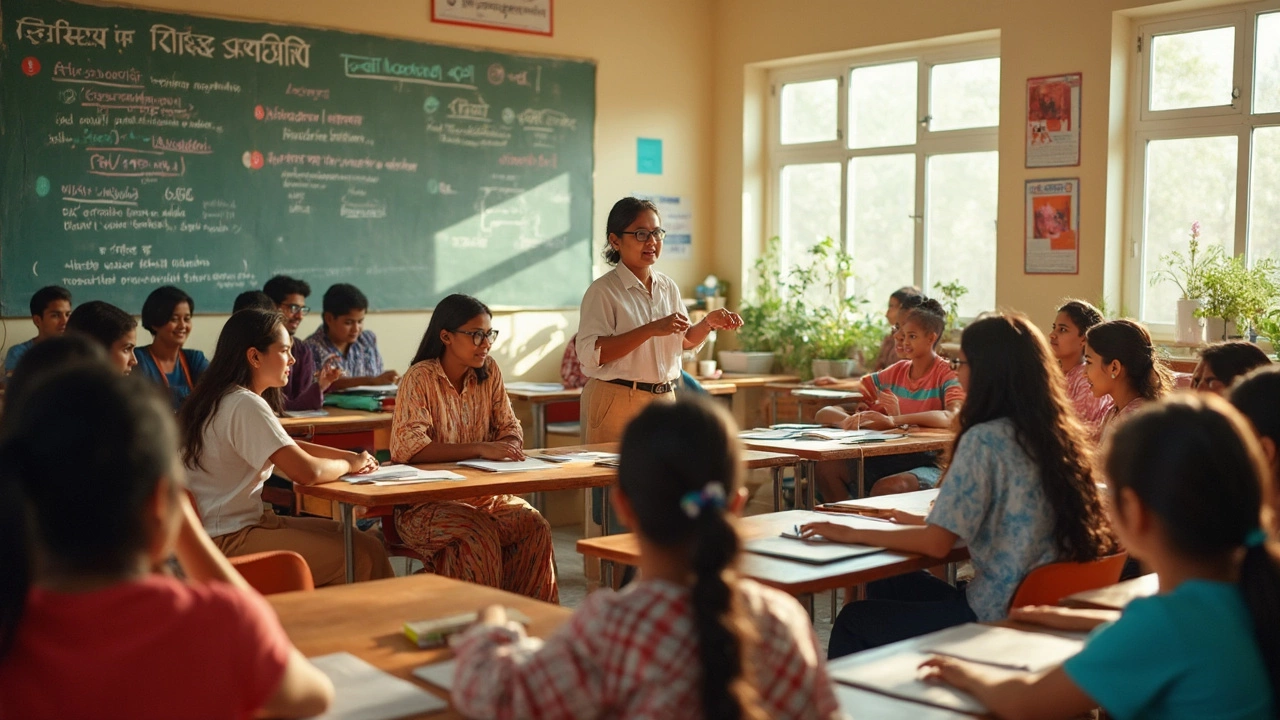Ever heard someone mention a “normal school” and thought it sounded outdated or just plain weird? That’s actually one of the oldest terms for a teacher training school, and it’s still used in some places. These schools go by a bunch of other names too, like “training college,” “teacher’s college,” “teacher preparation center,” or the official-sounding “faculty of education.” Each name tells you a little bit about what goes on inside—training people to actually stand in front of a class and teach.
If you’re thinking about getting into teaching, or just curious how teachers level up their skills, understanding these different names helps you spot the right courses or programs. Some places stick to old-school terms, while others update their language—so a “normal school” might sound vintage, but it’s packed with courses, workshops, and teaching practice, just like newer “educator prep programs.”
People have been running these schools since the early 1800s. The first modern normal school opened in France in the late 18th century, focused only on teacher training. Later, countries like the US, UK, and Japan started their own versions. So when someone says “normal school,” you’re hearing a slice of teaching history.
- Alternative Names Explained
- How Teacher Training Schools Work
- Global Approaches to Teacher Education
- Tips for Choosing the Right Program
Alternative Names Explained
It’s easy to get confused when you hear all the different names for a teacher training school. Some sound old-school, others seem more modern, and a few might seem interchangeable even though they aren’t quite the same thing. Here’s a breakdown of the most common names and what they really mean.
- Normal School: This term comes from France—“école normale”—and it was all about setting the “norm” for teaching back in the 1800s. If you spot a university building with “normal” in its name, it started out as a teacher training center. In the US, Massachusetts was the first state to open a normal school in 1839. The term’s old, but you’ll still run into it in some countries.
- Teacher’s College: This name pops up a lot in English-speaking countries. It’s usually a dedicated part of a university or its own institution, just for training future teachers.
- Faculty of Education: Most universities now use this term for the department that runs all the teaching programs. If you want a bachelor’s or master’s in education, you’re probably enrolling in the Faculty of Education.
- Institute of Education: You’ll see this a lot in the UK and Australia. It focuses on teacher training but also runs research on education methods and policies.
- Training College: Common in Africa, South Asia, and parts of Europe. It might be a standalone school just for teacher prep, not always tied to a big university.
It’s worth knowing these names because the structure and style of teacher training can change depending on what the place is called. For example, a Faculty of Education within a university might offer more research-based or theory-heavy programs, while a traditional normal school focuses more on practical teaching methods and classroom experience.
Here’s a quick look at how often some of these names pop up in a few countries:
| Country | Common Name(s) | First Opened |
|---|---|---|
| USA | Normal School, Teacher's College | 1839 (Massachusetts) |
| UK | Institute of Education, Faculty of Education | 1840s (London) |
| Japan | Normal School | 1872 (Tokyo) |
| Australia | Institute of Education, Teacher's College | 1850 (Sydney) |
| Kenya | Training College | 1920s |
The takeaway? If someone talks about a normal school or training college, they’re almost always talking about teacher training—even if the name sounds a little different from what you’re used to. If you’re considering applying, always check the entrance requirements and focus areas, because these can vary a lot depending on the institution’s tradition and setup.
How Teacher Training Schools Work
So how does a teacher training school actually run? These places mix classroom learning with hands-on teaching practice. It’s not just about reading textbooks or taking notes. The goal is to help future teachers get comfortable working with real students, not just talking about it in theory.
Every program is built around a few main pieces:
- Lectures and Classes: Here, you’ll study how people learn, what motivates students, and how to handle tricky classroom situations. Subjects can include child development, lesson planning, special education, and using technology for teaching.
- Practical Training: Most schools require student-teaching or internships. Think of it like a practice run, but with real kids. You plan lessons, teach, get feedback from experienced educators, and try new classroom strategies.
- Workshops and Seminars: These focus on special skills you don’t always pick up in regular lectures—like dealing with bullying, classroom safety, or teaching kids with learning differences.
- Assessment and Exams: There’s no dodging tests. You’re graded not just on what you know, but how you teach, interact with kids, and grow during your training.
Some schools tie up with public schools or local education centers, so you get direct access to real classrooms. Others even have their student-teachers run after-school clubs or homework help sessions.
Here’s a look at teacher training school basics in a nutshell:
| What You Learn | How Long It Takes | Main Activities |
|---|---|---|
| Education theory, classroom management, child psychology, subject expertise | Usually 1-2 years for initial certification courses, 3-4 years for degree programs | Lectures, teaching practice, workshops, exams |
Recent numbers from the U.S. Department of Education show that over 170,000 people complete teacher prep programs every year in the States alone. This isn’t just a quick training—you get real, guided experience before ending up in your own classroom. A good training school doesn’t just hand out diplomas; it gives you practical tools and support that keep you going once you land the job.

Global Approaches to Teacher Education
Every country puts its own spin on training teachers. Some governments run tight, centralized systems, while others leave a lot of room for local schools to decide how things are done. The differences might surprise you.
Take Finland. It's famous for top-notch education, and all teachers there must earn a master’s degree to teach—even in elementary school. A ton of focus is placed on both theory and hands-on practice, which many say leads to high teacher morale and better student outcomes.
Now look at the U.S. Here, you’ll find colleges and universities offering a wild mix of degree programs, from bachelor’s to master’s, plus loads of credential tracks. Some states say a four-year teaching degree is enough. Others require extra student teaching or passing tough state exams. Private certification programs like Teach For America shake things up further by offering alternative routes to the classroom.
If you check out Japan, they keep it straightforward: aspiring teachers must finish a university degree in education and then pass national exams before getting a permanent job. New teachers start with a one-year internship supervised by a veteran, which makes sure they’re not thrown in the deep end.
Here’s a quick look at how teacher training breaks down in different places:
| Country | Program Length | Key Requirement |
|---|---|---|
| Finland | 5-6 years | Master’s in education + classroom practice |
| United States | 4-6 years | Bachelor’s/alternative routes + state exam |
| Japan | 4 years | Education degree + national exam + internship |
| UK | 3-4 years | BA in Education or PGCE + placement |
One thing is clear: there’s no single way to become a teacher. If you’re thinking about teacher training school, check the entry requirements and style in your country. Some places are strict about degrees and certifications, while others are open to people from different backgrounds. Also, watch out for the term teacher training school—sometimes the programs actually go by a different name. Always double-check before you sign up.
Tips for Choosing the Right Program
Picking a teacher training school can seriously shape your future in education. There’s way more to it than just picking the place closest to home. Here’s what actually matters when you’re looking at your options.
- Accreditation is your first checkpoint. If the program isn’t certified by your country’s main education authority, steer clear—graduating from a non-accredited place usually means you can’t get licensed to teach.
- Look at how much real classroom experience you get. You want a program that puts you in front of students early and often—not just listening to lectures about teaching theory.
- Pay attention to the job placement rates. If most graduates land teaching jobs within six months, that’s a good sign. Ask the admissions team for real numbers, not just promises.
- Some programs focus on elementary teaching, others on high school, and a few even let you specialize in subjects like science, math, or foreign languages. Grab the one that lines up with your future goals.
- Find out what support you get. Good schools offer career advice, mentoring, and maybe even help you ace your teaching exams.
Curious about how different schools stack up with the facts? Check out the quick stats below on teacher training program outcomes from well-known countries:
| Country | Average Student Teaching Hours | Job Placement Rate | Accreditation Required? |
|---|---|---|---|
| USA | ~600 hours | 87% | Yes |
| UK | ~750 hours | 92% | Yes |
| Australia | ~600 hours | 85% | Yes |
| Japan | ~540 hours | 90% | Yes |
Don’t forget to check out online reviews from actual students. They usually tell it straight—if a teacher training school is more about paperwork than prepping you for the classroom, you’ll hear about it. A great program will push you, give you genuine teaching practice, and help you step right into your first teaching gig with confidence.

